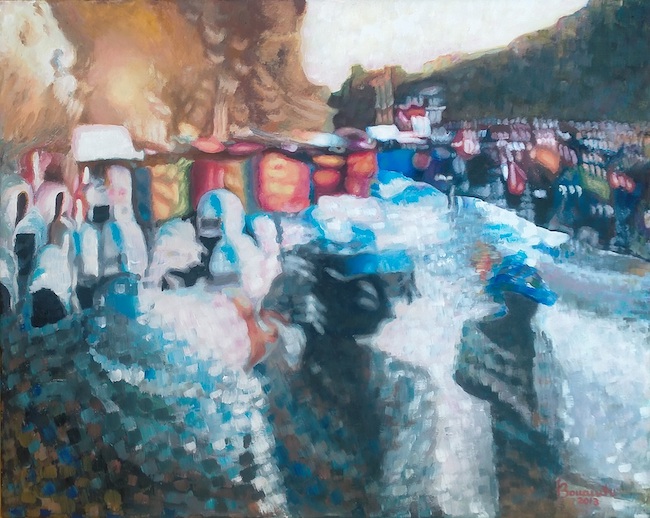Nel panorama artistico contemporaneo sembra a volte esservi una distinzione netta tra chi desidera riprodurre in maniera quasi fedele la realtà osservata, in alcuni casi avvicinandosi alle immagini fotografiche al punto di non riuscire a distinguerle dall’opera d’arte, e chi invece preferisce navigare nel mare dell’indefinito orientandosi a un linguaggio privo di ogni contatto con ciò che lo sguardo è abituato a osservare, declinato secondo l’intensità espressiva e la specifica personalità dell’esecutore dell’opera. La protagonista di oggi crea una terra di mezzo tra le due distanti posizioni mescolando il desiderio di aderire alla realtà osservata a quello di lasciarne trasparire l’essenza, l’aspetto generale.
Il Ventesimo secolo ha determinato una vera e propria rivoluzione in campo artistico, a causa dei vari movimenti che hanno fortemente voluto creare una frattura netta con il passato sovvertendo ogni regola stilistica e introducendo inediti approcci esecutivi e punti di vista sul modo di fare arte, ma anche per la profonda diversità che ciascuna corrente presentava non solo dalle altre coeve bensì anche al proprio interno accogliendo e incentivando la personalizzazione artistica dei loro componenti. Non solo, con il proseguire dei decenni si sono verificati ritorni nostalgici al figurativismo del secolo precedente oppure, al contrario, estremizzazioni della necessità di frammentare o scomporre la realtà osservata fin quasi a non riconoscerla. Dall’Espressionismo, irriverente, impreciso, antiestetico, improbabile sia nelle forme che nei colori, si è così andati verso l’Espressionismo Astratto in cui tutto ciò che doveva trapelare era l’intensità emotiva dell’artista, affermando così quanto l’arte fosse al di sopra di ogni contingenza, superiore a ogni altro mezzo di riproduzione dell’immagine, come la tecnica fotografica in via di perfezionamento, e lontana da ciascun evento tragico o terrificante come i conflitti mondiali. D’altro canto però, in particolar modo negli Stati Uniti, stava sorgendo un nuovo movimento pittorico che intendeva invece avvicinarsi sempre di più alla precisione visiva delle immagini immortalate dalle macchine fotografiche, per mostrare quanto un artista potesse tenere testa e anche oltrepassare la perfezione tecnologica; il nuovo stile prese inizialmente il nome di Fotorealismo ed ebbe i suoi massimi esponenti in Richard Estes e in Ralph Goings, e poi si spostò verso l’Iperrealismo con un consolidamento della tecnica ma anche un’apertura al dettaglio che rivela l’invisibile, ciò che sfugge allo sguardo umano, oltre all’introduzione di concetti e di dettagli tendenti alla Metafisica, come nelle tele di Gottfried Helnwein e di Tjalf Sparnaay. A una tale estremizzazione della fedeltà all’osservato si affianca anche una necessità di frammentare, di sfocare per poi osservare l’insieme generato, che contraddistingue alcuni artisti appartenenti all’Impressionismo Contemporaneo tra cui uno dei maggiori esponenti è Jeremy Mann, le cui vedute di città metropolitane non possono fare a meno di incantare l’osservatore. All’interno di questa libertà espressiva ed evoluzione di stili precedenti che via via assumono caratteristiche individuali e personali sulla base dell’impulso creativo, si colloca il personale approccio pittorico dell’artista laziale Franca Bonaiuti, la cui attenzione al dettaglio e la ricerca della perfezione esecutiva l’hanno spinta a superarsi, a mettersi alla prova, a ironizzare proprio sulla sua puntigliosità approdando a uno stile in cui tutto ciò che è importante per lei viene osservato attraverso una lente da miope in grado di sfocare ogni cosa, di cancellare proprio il particolare che tanto le è caro nella gestione della vita quotidiana così come lo è stato nello stile pittorico che l’ha caratterizzata in precedenza.
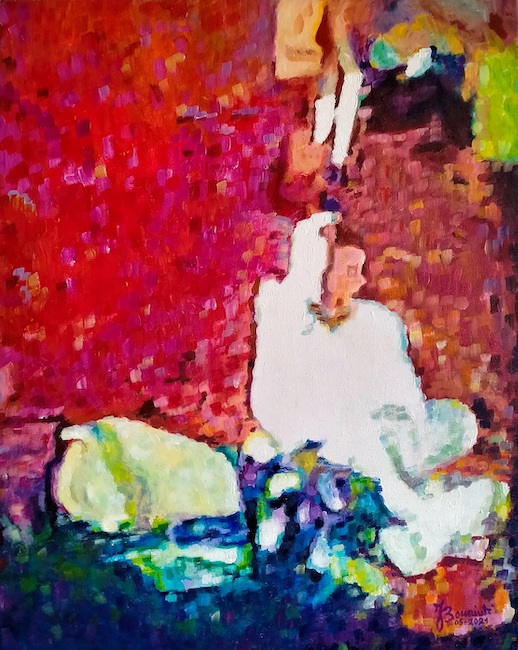
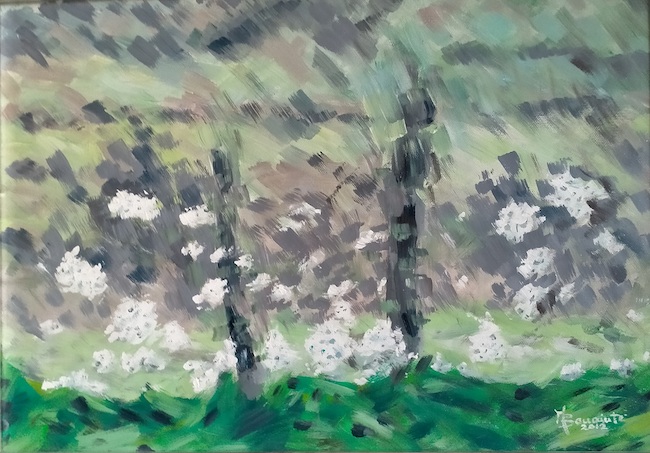
Incline all’arte fin da bambina, incentivata dalle maestre a non abbandonare il suo impulso creativo, ha poi compiuto scelte di vita che l’hanno tenuta parzialmente lontana dai circuiti delle mostre, coltivando così l’arte solo come hobby fino al momento in cui non ha più potuto trattenerla e ha così cominciato a mostrare all’esterno le sue tele partecipando a mostre collettive. In un modo completamente suo e personale, la Bonaiuti riprende la poetica pittorica del sudafricano Philip Barlow per il quale la luce e il colore trasmutano l’osservato conducendolo verso un’inedita forma di Astrattismo in cui la figurazione resta la base imprescindibile.
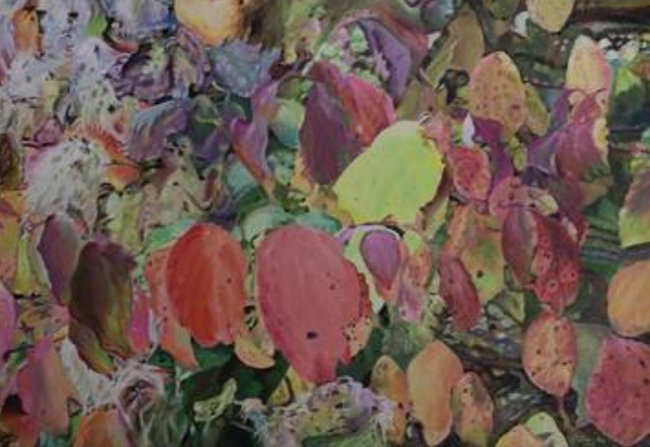
La dissoluzione del dettaglio delle opere della Bonaiuti induce lo sguardo a perdersi nell’insieme, a indagare il contesto ma anche la realtà sottesa di cui l’artista desidera raccontare, come se l’essere avvolta da una nebbia visiva rendesse tutto più stimolante e affascinante; in qualche modo manifesta il suo punto di osservazione sulla realtà contemporanea troppo orientata all’apparenza, a mostrare in maniera aperta la superficie senza andare a fondo dell’essenza, della sostanza di ciò che circonda l’individuo. L’invito a soffermarsi sul non visibile, a trascurare il particolare per respirare l’atmosfera che circonda un paesaggio, un evento, una circostanza, diviene il tratto distintivo di questa originale artista, sperimentatrice di un linguaggio pittorico in grado di conquistare l’osservatore.
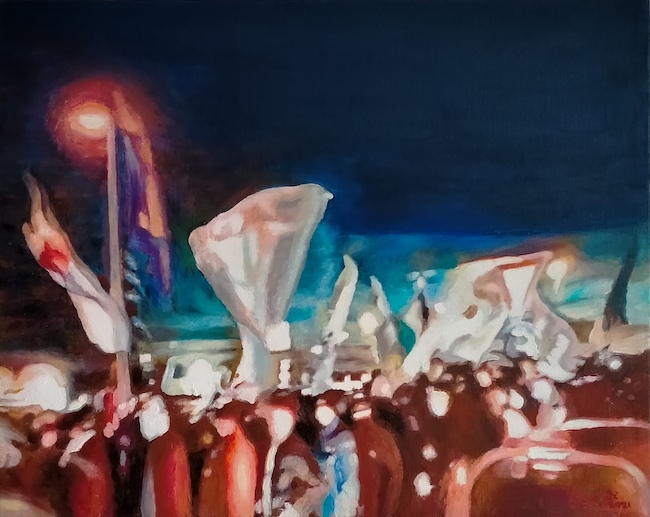
Nella tela Processione laica le figure umane sono completamente sfocate, così come lo sono i dettagli delle strade e delle vie in cui ha luogo il corteo, perché per la Bonaiuti non è importante il dove e il chi, piuttosto ciò che conta è l’intensità del frangente, la coralità di un accadimento che accomuna individui differenti ma uniti da uno scopo, un credo comune che li induce a unirsi; non sono dunque essenziali i volti, le singolarità, è essenziale l’atmosfera generata da quell’associarsi per celebrare un evento di quella piccola società costituita dai protagonisti inconsapevoli dello sguardo dell’artista.
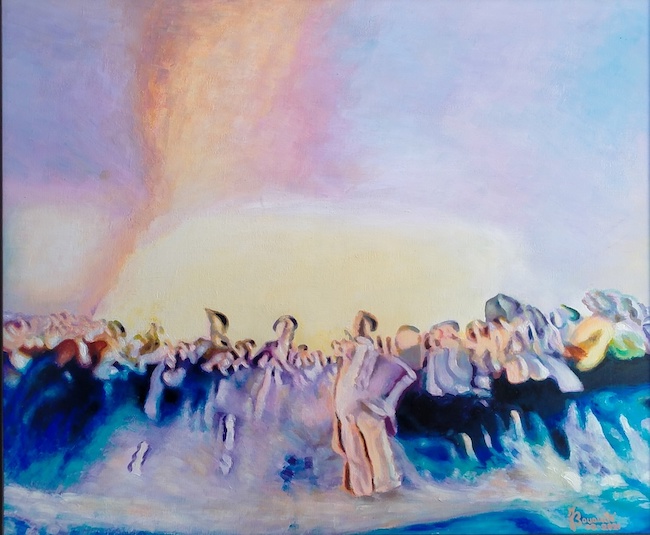
L’opera Anelito dell’anima riprende il concetto di comunità, di raggruppamento di individui in questo caso raffigurati quasi come in sogno, come se costituissero un auspicio di Franca Bonaiuti che le popolazioni si uniscano in virtù dell’interiorità, di quell’essere simili dal punto di vista emotivo malgrado le differenze esterne, che rappresenta il mezzo migliore per comprendersi, per accogliersi vicendevolmente e insieme procedere per percorrere l’esistenza in maniera più piacevole, meno competitiva, più serena proprio grazie alla solidarietà che lega l’essere umano a livello istintivo e primordiale.
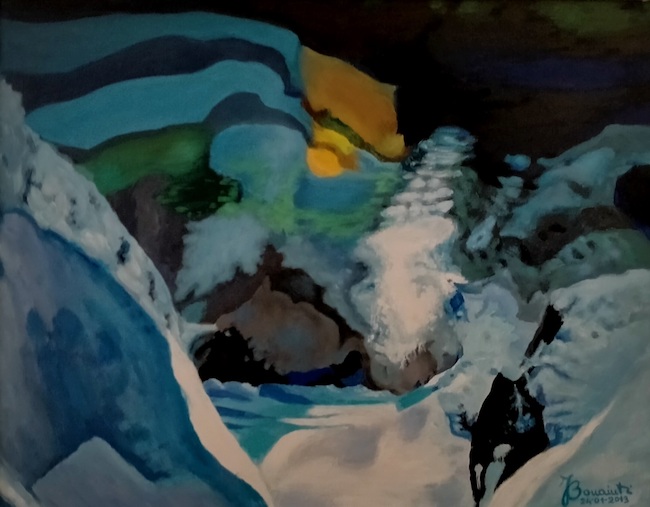
In Blue ice invece l’artista si sposta verso il paesaggio, un mondo indistinto osservato con sguardo miope in cui ciò che emerge è l’impressione ricevuta dall’interiorità nell’istante in cui l’occhio ha catturato l’immagine che poi si è spostata verso l’universo emozionale al punto di indurre la mente a tralasciare il dettaglio per farsi trasportare dall’intensità del ricordo del momento in cui lo sguardo si è poggiato sul panorama fissandosi nella memoria. Il paesaggio è innevato e si intravedono delle case con i tetti bianchi contornate da alberi anch’essi imbiancati, quasi come se la Bonaiuti avesse aperto una porta all’ingresso di una favola dove tutto è morbido, sereno, piacevole ed è questo ciò che predomina nell’opera, quel senso di silenzio e di pace accresciuto proprio dalla sfocatura dell’immagine, da quell’indefinito che nelle opere dell’artista sembra essere accogliente piuttosto che destabilizzante come lo è invece nel vivere contemporaneo.
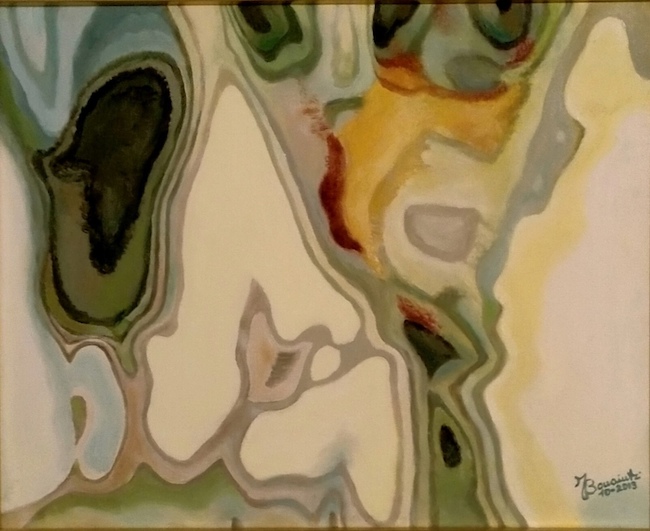
Ne dipinto Il professore si sposta verso un Astrattismo in cui la figurazione si perde all’interno di tonalità che rappresentano la sostanza, l’approccio intellettuale, quell’osservare la realtà attraverso una gamma cromatica mentale, razionale, composta di beige, di grigio, di giallo tenue, come se l’equilibrio del personaggio raccontato potesse essere rappresentato solo da semitoni, dall’impalpabilità del sapere e della saggezza che pervadono l’intera atmosfera dell’opera. La capacità di Franca Bonaiuti di confondere lo sguardo per attrarlo in virtù del senso più profondo dell’osservato è frutto di una ricerca pittorica in continua evoluzione che le ha permesso di sviluppare uno stile personale e certamente affascinante; l’artista ha all’attivo molte mostre collettive su tutto il territorio nazionale tra cui Torino, Roma, Milano, e nel mese di dicembre 2021 ha esposto come ospite alla mostra dei Cento Pittori di via Margutta.
FRANCA BONAIUTI-CONTATTI
Email: chiara85.pasquali@gmail.com
Facebook: https://www.facebook.com/franca.bonaiuti
Franca Bonaiuti’s blurred visions, between the desire to go beyond detail and the need to consider the whole
In the contemporary art scene, there sometimes seems to be a clear distinction between those who wish to reproduce the observed reality almost faithfully, in some cases approaching photographic images to the point of being unable to distinguish them from the work of art, and those who prefer to navigate in the sea of the indefinite, orienting themselves towards a language that has no contact with what the eye is used to observe, declined according to the expressive intensity and the specific personality of the artwork’s creator. Today’s protagonist creates a middle ground between the two distant positions, mixing the desire to adhere to the observed reality with the desire to reveal its essence, its general aspect.
The twentieth century brought about a real revolution in the field of art, due to the various movements that strongly wished to create a clear break with the past by subverting every stylistic rule and introducing new approaches to execution and points of view on the way of making art, but also because of the profound diversity that each current presented not only from the others of the same period but also within itself, welcoming and encouraging the artistic personalisation of its components. Not only that, but as the decades went by, there were nostalgic returns to the figurative art of the previous century or, on the contrary, extremes of the need to fragment or decompose the observed reality to the point of almost not recognising it.
From the irreverent, imprecise, unaesthetic, improbable Expressionism, both in form and colour, we moved towards Abstract Expressionism in which all that had to transpire was the emotional intensity of the artist, thus affirming that art was above all contingencies, superior to any other means of image reproduction, such as the photographic technique that was being perfected, and far from any tragic or terrifying event such as the world wars. On the other hand, however, particularly in the United States, was emerging a new pictorial movement that sought to come ever closer to the visual precision of the images captured by cameras, to show how much an artist could hold his own and even go beyond technological perfection; the new style initially took the name of Photorealism and had its greatest exponents in Richard Estes and Ralph Goings, then moved towards Iperrealism with a consolidation of technique but also an openness to detail that reveals the invisible, that which escapes the human eye, as well as the introduction of concepts and details tending towards Metaphysics, as in the paintings of Gottfried Helnwein and Tjalf Sparnaay. This extreme fidelity to the observed is accompanied by a need to fragment, to blur in order to observe the generated whole, which characterises certain artists belonging to Contemporary Impressionism, one of the greatest exponents of which is Jeremy Mann whose views of metropolitan cities cannot fail to enchant the observer. Within this freedom of expression and evolution of previous styles, which gradually take on individual and personal characteristics on the basis of the creative impulse, lies the personal pictorial approach of the Lazio artist Franca Bonaiuti, whose attention to detail and search for perfection in execution have pushed her to surpass herself, to prove herself, to make fun of her own meticulousness, arriving at a style in which everything that is important to her is observed through a myopic lens capable of blurring everything, of erasing the very detail that is so dear to her in the management of daily life, just as it was in the painting style that characterised her previously.
Inclined to art since she was a child, encouraged by her teachers not to abandon her creative impulse, she then made life choices that kept her partly away from exhibition circuits, cultivating art only as a hobby until the moment when she could no longer hold it back and began to show her canvases to the outside world by participating in collective exhibitions. In her own personal way, Bonaiuti takes up the pictorial poetics of the South African Philip Barlow, for whom light and colour transmute the observed, leading him towards a new form of Abstractionism in which figuration remains the essential basis. The dissolution of detail in Bonaiuti’s paintings induces the gaze to lose itself in the whole, to investigate the context but also the underlying reality of which the artist wishes to tell, as if being enveloped in a visual fog made everything more stimulating and fascinating; in some way she manifests her point of view on contemporary reality, too appearance-oriented, openly showing the surface without getting to the bottom of the essence, the substance of what surrounds the individual. The invitation to dwell on the non-visible, to neglect the detail in order to breathe in the atmosphere surrounding a landscape, an event, a circumstance, becomes the distinctive feature of this original artist, who experiments with a pictorial language capable of captivating the observer.
In the painting Processione laica (Lay Procession) the human figures are completely out of focus, as are the details of the streets and roads where the procession takes place, because for Bonaiuti it is not important where or who, but rather the intensity of the event, the chorus of an event that brings together different individuals but united by a purpose, a common creed that brings them together; The faces and singularities are not essential; what is essential is the atmosphere generated by that coming together to celebrate an event in that small society made up of the unwitting protagonists of the artist’s gaze. The work Anelito dell’anima (Yearning of the soul) takes up the concept of community, of a grouping of individuals, in this case depicted almost as if in a dream, as if it were Franca Bonaiuti’s wish that people would unite by virtue of their interiority, of that being emotionally similar despite external differences which is the best way to understand each other, to welcome each other and together going through life in a more pleasant, less competitive and more serene way, thanks to the solidarity that binds human beings at an instinctive and primordial level. In Blue Ice, on the other hand, the artist moves towards the landscape, an indistinct world observed with a myopic gaze where what emerges is the impression received from the interiority in the instant in which the eye has captured the image, that has then moved towards the emotional universe to the point of inducing the mind to leave out the detail to be transported by the intensity of the memory of the moment in which the gaze rested on the panorama, fixing itself in the memory.
The landscape is snow-covered and can be glimpsed houses with white roofs surrounded by trees that have also been whitewashed, almost as if Bonaiuti had opened a door at the entrance to a fairytale where everything is soft, serene and pleasant, and this is what predominates in the painting, that sense of silence and peace enhanced by the blurring of the image, by that indefinite which in the artist’s work seems to be welcoming rather than destabilising as it is in contemporary life. In the painting Il professore (The Professor) shifts towards an Abstractionism in which the figuration is lost within tones that represent the substance, the intellectual approach, that observation of reality through a mental, rational chromatic range, composed of beige, grey, soft yellow, as if the balance of the character told could only be represented by semitones, by the impalpability of knowledge and wisdom that pervade the entire atmosphere of the artwork. Franca Bonaiuti’s ability to confuse the gaze in order to attract it by virtue of the deeper sense of the observed is the result of a pictorial research in continuous evolution that has allowed her to develop a personal and certainly fascinating style; the artist has to her credit many collective exhibitions throughout the country including Turin, Rome, Milan, and in December 2021 she exhibited as a guest at the Cento Pittori di via Margutta exhibition.


